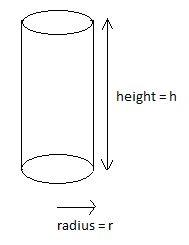Answer
411.3k+ views
Hint: Assume that the radius and height of the right circular cylinder is ‘r’ and ‘h’ respectively. Use the formula for volume of cylinder: $V=\pi {{r}^{2}}h$, where ‘V’ is the volume. Now, use the formula for curved surface area of the cylinder: $C.S.A=2\pi rh$, where C.S.A is the curved surface area. Divide the volume of the cylinder by its curved surface area and cancel the common terms. The dimension or expression left after simplifying is the required answer.
Complete step-by-step answer:
Let us assume that the radius and height of the right circular cylinder is ‘r’ and ‘h’ respectively.

Therefore, the Volume (V) of this cylinder is given by:
\[V=\pi {{r}^{2}}h.......................(i)\]
Also, the curved surface area (C.S.A) of this cylinder is given by:
$C.S.A=2\pi rh.....................(ii)$
Now, dividing equation (i) by equation (ii), we have,
$\dfrac{V}{C.S.A}=\dfrac{\pi {{r}^{2}}h}{2\pi rh}$
Cancelling the common terms, we get,
$\dfrac{V}{C.S.A}=\dfrac{r}{2}$
By cross-multiplication, we get,
$V=\dfrac{r}{2}\times C.S.A$
Clearly, we can see that the volume of the cylinder is $\dfrac{\text{Radius}}{2}$ times the curved surface area of the cylinder.
Hence, option (a) is the correct answer.
Note: Do not use the formula for total surface area of the cylinder, as we will get the wrong answer. Remember that the unit of volume is cubic units while the unit of area is square units. In the above solution, we have divided the volume by the curved surface area. We may also divide the curved surface area by the volume and take its reciprocal to get the relation: $V=\dfrac{r}{2}\times C.S.A$. The final answer will not change on simplification.
Complete step-by-step answer:
Let us assume that the radius and height of the right circular cylinder is ‘r’ and ‘h’ respectively.

Therefore, the Volume (V) of this cylinder is given by:
\[V=\pi {{r}^{2}}h.......................(i)\]
Also, the curved surface area (C.S.A) of this cylinder is given by:
$C.S.A=2\pi rh.....................(ii)$
Now, dividing equation (i) by equation (ii), we have,
$\dfrac{V}{C.S.A}=\dfrac{\pi {{r}^{2}}h}{2\pi rh}$
Cancelling the common terms, we get,
$\dfrac{V}{C.S.A}=\dfrac{r}{2}$
By cross-multiplication, we get,
$V=\dfrac{r}{2}\times C.S.A$
Clearly, we can see that the volume of the cylinder is $\dfrac{\text{Radius}}{2}$ times the curved surface area of the cylinder.
Hence, option (a) is the correct answer.
Note: Do not use the formula for total surface area of the cylinder, as we will get the wrong answer. Remember that the unit of volume is cubic units while the unit of area is square units. In the above solution, we have divided the volume by the curved surface area. We may also divide the curved surface area by the volume and take its reciprocal to get the relation: $V=\dfrac{r}{2}\times C.S.A$. The final answer will not change on simplification.
Recently Updated Pages
The branch of science which deals with nature and natural class 10 physics CBSE

The Equation xxx + 2 is Satisfied when x is Equal to Class 10 Maths

Define absolute refractive index of a medium

Find out what do the algal bloom and redtides sign class 10 biology CBSE

Prove that the function fleft x right xn is continuous class 12 maths CBSE

Find the values of other five trigonometric functions class 10 maths CBSE

Trending doubts
Difference between Prokaryotic cell and Eukaryotic class 11 biology CBSE

Fill the blanks with the suitable prepositions 1 The class 9 english CBSE

Write an application to the principal requesting five class 10 english CBSE

Difference Between Plant Cell and Animal Cell

a Tabulate the differences in the characteristics of class 12 chemistry CBSE

Change the following sentences into negative and interrogative class 10 english CBSE

What organs are located on the left side of your body class 11 biology CBSE

Discuss what these phrases mean to you A a yellow wood class 9 english CBSE

List some examples of Rabi and Kharif crops class 8 biology CBSE



